2023.08.02.92
Files > Volume 8 > Vol 8 No 2 2023
Response of Potato to Organic Fertilizer and Zinc Sulfate Spraying on some Growth Characteristics and Yield
1 Anbar University; College of Agriculture; [email protected] .
* Correspondence: [email protected];
Available from: http://dx.doi.org/10.21931/RB/2023.08.02.92
ABSTRACT
A field experiment was carried out at the research station of the College of Agriculture, University of Anbar, for the spring season 2021-2022 to study the effect of adding organic fertilizer and spraying with zinc sulfate on two cultivars of Solanum tuberosum L. The study was carried out as a factorial experiment within the design of completely randomized sectors (RCBD); the first factor included composting transactions ten transactions Control treatment, chemical fertilization treatment, organic fertilization poultry treatment 50 g.plant, organic fertilization treatment 100 g.plant, spraying treatment 1 g zinc sulfate. Plant, spraying treatment 3 g zinc sulfate.plant, interaction treatment 50 g.organic fertilizer plant + 1 g zinc sulfate Overlap treatment 50 g.organic fertilizer plant +3g zinc sulfate, overlap treatment 100g.organic fertilizer plant +1g zinc sulfate, overlap treatment 100g organic fertilizer plant +3g zinc sulfate). The second factor included the two potato cultivars, Naima and Challenger rank Elite. The total transactions amounted to 20 treatments and were repeated thrice, bringing the whole to 60 experimental units. The averages were compared at a 5% probability level: the Challenger variety gave the highest value for the number of main aerial stems, 2,220. plant̄¹ and the highest value for plant lengths is 85,754 cm. plant̄¹, the leaf area is 98,880 dm2 plants̄¹, and the average number of tubers per plant is 6.799 tubers plant̄¹. The variety Naima gave the highest value for the yield of one plant, 1049.60 g. plant̄¹ and the total yield of tubers is 49.11 tons ha -¹. Adding 50 gm of organic fertilizer + 1 gm of zinc sulfate was significantly superior to the number of main aerial stems of 2.933. plant̄¹, adding 100 gm of organic fertilizer + spraying 1 gm of zinc sulfate was superior in plant height 98.130 cm while adding 100 gm of organic fertilizer + spraying 3 gm of zinc sulfate was significantly superior in leaf area of 159.490 dm2 plants̄¹. Adding 100 gm of organic fertilizer + 1 gm of zinc sulfate significantly increased the yield of one plant, 1164.50 gm. Plant̄¹. Adding 100 gm of organic fertilizer and spraying 3 gm of zinc sulfate was significantly superior to the total yield of 62.03 tons ha-¹.
Keywords: Potato, Organic Fertilizer, Zinc Sulfate Spraying
INTRODUCTION
The potato crop Solanum tuberosum L. is a strategic vegetable crop and belongs to the Solanaceae family, which ranks second after cereals. It is a cheap energy source essential for many countries' food security. Therefore, attention must be paid to the reality of its cultivation and development, and it is one of the crops that stress the soil due to its voraciousness to absorb elements. This is due to the large size of the plant's vegetative total and the amount of tubers obtained during its growth period, which ranges between 90-120 days, depending on the varieties. In addition, it is considered the most important vegetable crop in the Arab world and in a large number of countries in the world, especially in the Americas and Europe. The potato is known in English as the potato or the Irish potato, about Ireland, where potato cultivation spread after being moved to South America after its discovery1. Adding organic fertilizers improves the soil's chemical, physical and biological properties in a way that gives a production called organic production, which does not contain any polluting trace of the mineral residues of pesticides, fertilizers, vaccines or growth regulators. Nutrients play a crucial role in the growth and production of potatoes, so feeding through leaves is an essential means to provide the plant's need for nutrients, which is reflected in the increase in growth and yield as well as to improve the quality2. It is possible to use foliar feeding by taking advantage of the plant's leaf area and the development of the vegetative group.
Zinc (Zn) is an essential nutrient classified nutritionally as one of the microelements plants need. Despite this, zinc deficiency in crops is widespread all over the world. Therefore, it has become essential to pay more attention to zinc nutrition in the production of crops in light of the continuous increase in the population in the world3. Plants need the formation of the amino acid TryptophanTryptophan, which consists of the hormone indole acetic acid (IAA) necessary for cell elongation4. Moreover, zinc is essential for phosphorylation, and the formation of glucose, and its deficiency stops the process of starch representation. The accumulation of fats, phospholipids and phenolic compounds in the succulent gap of the plant and zinc helps in the formation of chlorophyll due to its direct effect in the process of formation of amino acids, carbohydrates, nucleic acids, DNA and RNA and building carotenoids5. The variety is an important and influential factor in the productivity of this crop, as potatoes are grown in Iraq in many varieties. From this point of view, attention should be paid to the production of tubers suitable for cultivating both cultivars, with a preference for early ripening and abundant yielding varieties6.
Therefore, the study aimed to Study the effect of organic fertilization and zinc nutrition on the growth, yield and quality of two potato cultivars.
MATERIALS AND METHODS
The experiment was carried out at the College of Agriculture, University of Anbar's research station in the spring agricultural season 2022. Soil samples were taken for chemical and physical analyses (Table 1).
The land was prepared by cultivating it with a plow at a depth of 30 cm. The soil was smoothed and leveled and divided into three sectors, where the planting was carried out on a merouz, the length of the merouz is 6 m, the distance between a meadow and another is 75 cm, and the distance between one plant and another is 25 cm. The number of tubers in one experimental unit was 16 plants, with one mead per experimental unit. The area of the experimental unit was 6 m2, and a separation distance was left between the sectors and the experimental units to prevent the transfer of nutrients and fertilizers between treatments, leaving a buffer distance at the beginning and end of the sectors.
Factors and the experiment design: The study included the following elements:
1- Ground fertilization
T1: Comparison treatment without using organic or chemical fertilizers.
T2: Treatment of chemical fertilization7
T3: organic fertilization treatment 50 ton/ha
T4: Organic fertilizer treatment 100 ton/ha
2- foliar fertilization
T5: Spray treatment 1 g L-1 of zinc sulfate.
T6: Spray treatment 3 g L-1 of zinc sulfate.
3- Overlap (ground fertilization + foliar fertilization)
T7: 50 tons ha-1 of organic fertilizer + 1 g L-1 of zinc sulfate.
T8: 50 gm of organic fertilizer + 3 g L-1 of zinc sulfate.
T9: 100 tons ha-1 of organic fertilizer + 1 g L-1 of zinc sulfate.
T10: 100 gm of organic fertilizer + 3 g L-1 of zinc sulfate.
The factorial experiment used a randomized complete block design (RCBD). Factorial Experiment Within Randomized Complete Block Design with three replications, and each iterator consists of 20 treatments. It combines the two types and 10 treatments, so the number of experimental units becomes 3 x 10 x 2 = 60 experimental units at a rate of 20 plants for one experimental unit. The treatments were distributed randomly to each of the replicates. The process of analyzing the results using the Genstat program to compare the differences between the rates using the least significant difference (LSD) Lest Significant Difference test at a probability level of 0.058, Elite potato seeds were planted as Naima cultivar from French company GOPEX and challenger cultivar. From the Dutch company HZPC on 19/1/2022 in the spring season. The other crop service operations of the plant were also carried out, such as irrigation, hoeing, weeding and control, as recommended.
Studied Characteristics
The number of main aerial stems (stem.plant-1)
The number of main stems growing from under the soil's surface was calculated according to the average.
Plant height (cm)
According to the height of the plant, measuring the longest main stems in one plant from the soil surface level to the growing top of each experimental unit, then calculating the average.
Leaf area (dm2.plant-1)
The leaf area was measured using the Portable Leaf AM300 Area Meter after five plants were randomly selected from each treatment. Three medium-sized leaves were taken from the center of each plant. The leaf area of each plant was calculated based on the ratio between the dry weight of the fifteen leaves and its location with the dry weight. For the leaves of the five plants, the calculated total area was divided by five, and the result was taken as the leaf area per plant.
Number of tubers per plant (tuber. plant-1)
It was extracted by dividing the number of tubers in the treatment by the number of plants growing.
Yield per plant (g plant-1)
The total treatment was divided by the number of plants growing in it.
Total yield (ton. ha-1)
It was calculated after harvest by summing the total yield of the experimental unit and then proportioned to the hectare.
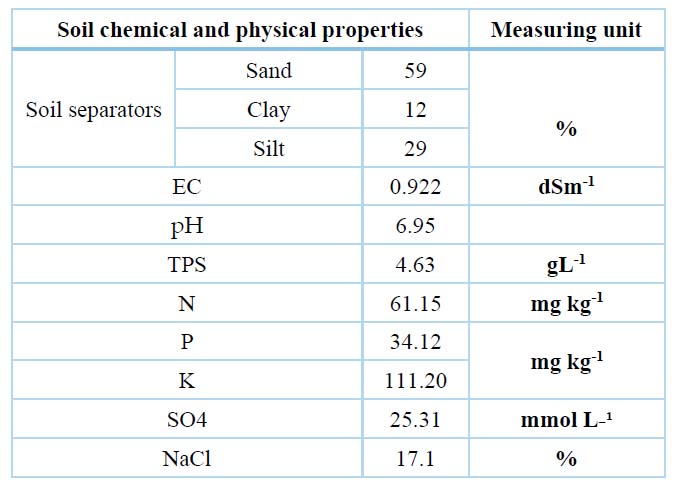
Table 1. Some of the soil's physical and chemical properties
RESULTS
Number of main aerial stems (stem plant ̄¹): The results of Table 2 show that there is a significant effect on the number of main stems, where the treatment (50 gm of organic fertilizer + 3 gm sprayed with zinc sulfate) T8 outperformed by giving it the highest number of branches that reached 2.933 stems. Plant ̄¹ had no significant effect on the two treatments, T9 and T10. Significant differences were observed with the previous two treatments compared to the rest of the factors T2, T3, T4, T5, T6, T7, and the comparison treatment T1.
The results of the table also showed the class V2 Challenge a significant superiority over the variety V1 Naima for the same trait by giving it the highest average number of main aerial stems, which amounted to 2,220 stems. plant̄¹ compared to cultivar V1, which gave 2.174 stems. plant̄¹.
As for the interaction, there showed no significance in this trait, Plant height (cm plant ̄¹): The results of the statistical analysis in Table 3 show the superiority of the treatment (100 gm of organic fertilizer + 1 gm sprayed with zinc sulfate) T9 by giving it the highest length of the main stem, which amounted to 98.130 cm which its no significant differ with the treatment T10, which amounted to 95,300 cm. plant̄¹ as well as compared to the control treatment T1, which gave 72.900 cm. plant̄¹. The results of the table also showed that the V2 Challenge cultivar significantly outperformed the V1 Naima cultivar for the same trait by giving it the highest average plant height of 85,754 cm. plant̄¹ compared to cultivar V1, which showed 79,960 cm. plant̄¹. As for the interference, there was no significant difference in this trait.
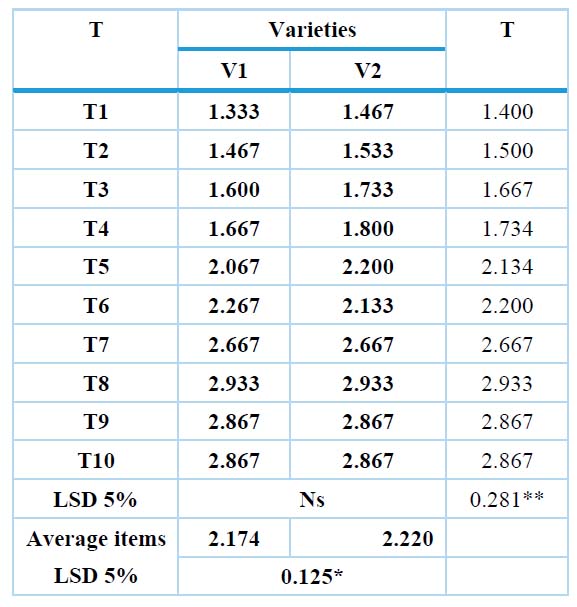
Table 2. Effect of adding organic fertilizer and spraying with zinc sulfate and the variety and the interaction between them on the number of main aerial stems (stalk. plant ̄¹) of the potato plant
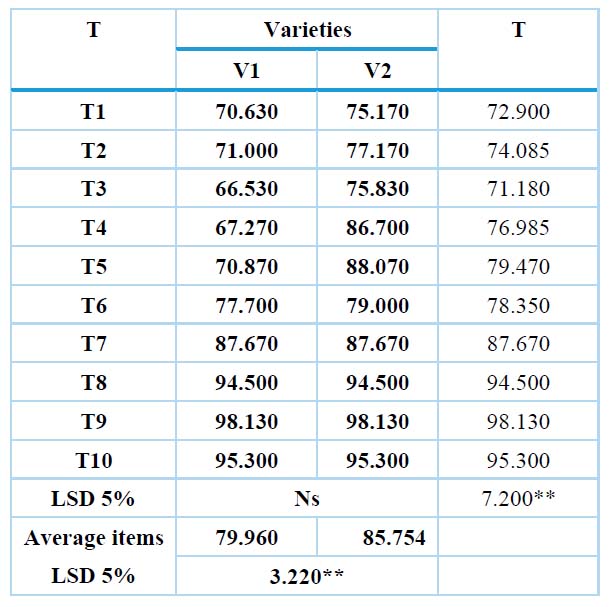
Table 3. Effect of treatments of organic fertilizer and spraying with zinc sulfate and cultivar and the interaction between them on plant height (cm. plant̄¹) of the potato plant.
Leaf area (dm2 plants-1): It can be seen from the results of Table 4 that the treatment (100 gm of
Organic fertilizer + 3 gm sprayed with zinc sulfate (T10) was superior by giving it the highest average leaf area, which amounted to 159.490 dm2 plants-1, compared with the comparison treatment T1, which gave the lowest value of 55,690 dm 2 plants̄¹. The results of the table also showed the superiority of the variety Challenger V2 as the results of the table showed the superiority of the variety Challenger V2 significantly over the variety.
V1 Naima for the same trait by giving it the highest average leaf area amounted to 98,880 dm 2 plants̄¹ compared to the V1 variety, which gave 95,036 dm 2 plants̄¹. As for the interference? The T10 treatment of both cultivars (100 gm of organic fertilizer + 3 gm sprayed with zinc sulfate) showed significant superiority in this trait, which amounted to 159.490 dm2 plants̄¹ compared to the measurement treatment of the first variety V1T1, which gave the lowest value of 53,990 dm2 plants̄¹.
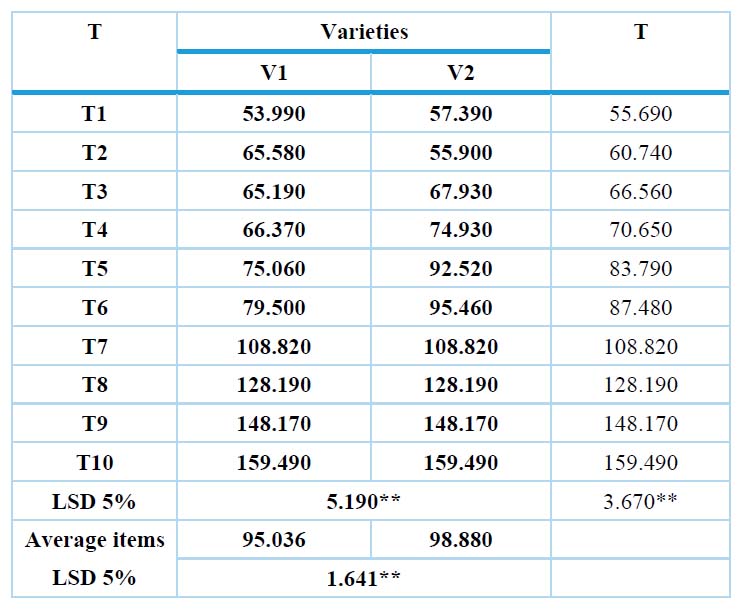
Table 4. Effect of organic fertilizer treatments and spraying with zinc sulfate and cultivar and their interaction on the potato plant's leaf area (dm2. plant̄¹).
The number of tubers per plant tuber.Plant ̄¹): The results of the statistical analysis in Table 5 showed the superiority of the treatment (100 gm of organic fertilizer + 3 gm sprayed with zinc sulfate) T10 by giving it the highest average number of tubers per plant amounted to 9,200 tubers. plant̄¹ by measure
With the comparison treatment T1, which gave the lowest value of 4.335 tubers. plant̄¹.
The table results also showed that the variety Challenger V2 was not significantly different from the variety V1 Naima for the same trait, as for the interference.
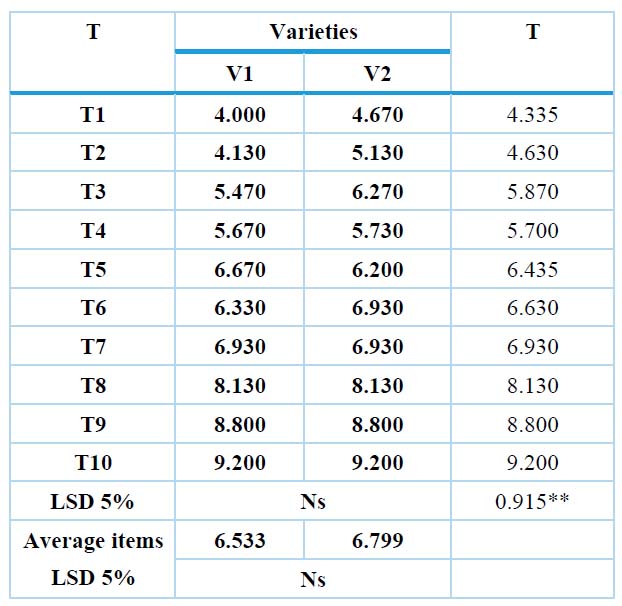
Table 5. measuring the number of tubers per plant (tuber plant̄¹) of the potato plant
There was no significant superiority in this trait
The yield of one plant (gm plant̄¹): It is noticed from the results of Table 6 that the treatment (100 gm of organic fertilizer + 1 gm sprayed with zinc sulfate) was superior to T9 by giving it the highest value of the yield of one plant, which amounted to 1164.50 gm. plant̄¹, and the T2 chemical fertilization treatment, which amounted to 681.80 gm, did not differ. plant̄¹ significantly higher than the T1 comparison treatment. The table results also showed that V1 Naima was significantly superior to Challenger V2 for the same characteristics by giving it.
Average top 1049.60 gm. plant̄¹ compared to variety V2, which gave 1019.25 g. plant̄¹. As for the interaction, the T9 treatment of both cultivars (100 gm of organic fertilizer + 1 gm sprayed with zinc sulfate) showed significant superiority in this trait, which amounted to 1164.50 gm. plant̄¹ compared to the measurement treatment for the second class
V2T1, which gave the lowest value of 649.40 gm plant̄¹, did not differ significantly from the interaction treatments V1T10, V2T10, V1T8, V2T8, V1T6 and V2T6 compared with the treatment V2T1, which gave the lowest value of 649.40 g. plant̄¹.
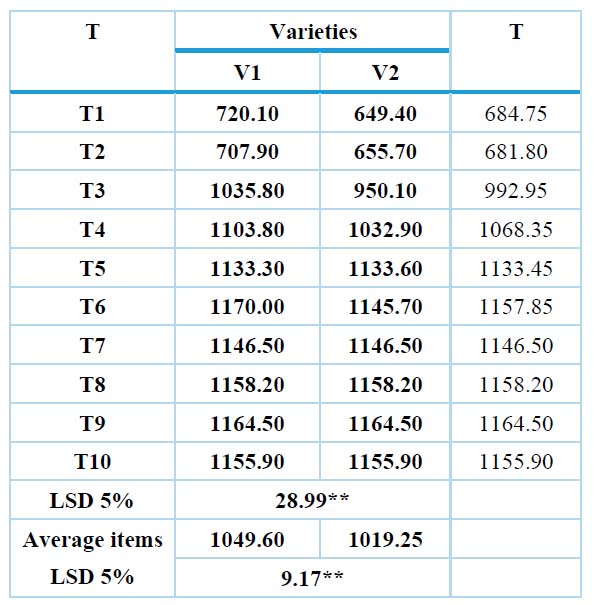
Table 6. Measuring the average yield per plant (gm plant̄¹) of potato plantا
The total yield (ton hectare -¹): The statistical analysis results are shown in Table 7.
The treatment (100 gm of organic fertilizer + 3 gm sprayed with zinc sulfate)T10 outperformed by giving it the highest average total yield of 62.03 tons ha-¹ compared with the control treatment T1, which gave the lowest value of 31.51 tonnes ha-¹.
The results of the table also showed that V1 Naima was significantly superior to Challenger V2 for the same characteristic by giving it an average of 49.11 tons ha-¹ compared to the V2 variety, which gave an average of 47.45 tons ha-¹.
As for the interaction, the T10 treatment for both cultivars (100 gm of organic fertilizer + 3 gm sprayed with zinc sulfate) showed a significant superiority in this trait, which amounted to 62.03 tons ha-¹ compared to the measurement treatment of the second class V2T1, which gave the lowest value of 30.45 tonnes ha-¹ and did not differ significantly. About the interference treatment V1T9 and V2T9.
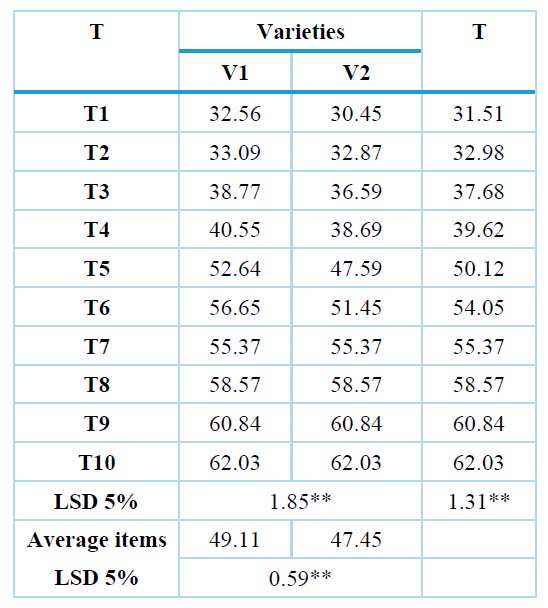
Table 7. measures the potato plant's total yield (ton hectares ̄¹).
DISCUSSION
Organic fertilizers are a source of macro and micro elements necessary for plant growth and provide the soil with humus, which improves its physical properties by increasing its ability to absorb and retain water. It reduces the loss of nutrients as well as increases the vital activity of microorganisms and gives a high-quality crop9 and10
The addition of the added organic fertilizers also led to an increase in the height of the plant, the number of main stems, the leaf area, the yield of one plant and the number of tubers per plant, as well as the total work, which is due to what animal waste contains major and minor elements necessary for plant growth (Table 1), especially the nitrogen element, which It is one of the essential nutrients needed for the plant after carbon, hydrogen and oxygen, and nitrogen affects the process of carbon metabolism, which increases the manufactured and stored materials in the plant11, 12and13.
These results are in agreement with14,15 16, who indicated the role and type of organic fertilizers and their effect on marketable yield and total yield by providing them with the necessary elements for the plant, especially the availability of nitrogen and potassium. The availability of nitrogen leads to an increase in the number of leaves, which, in turn, increases the effectiveness of carbon metabolism and the manufacture of carbohydrates. Potassium plays an active role in improving the vegetative growth characteristics of the plant, as well as its role in transferring the manufactured substances in the leaves to the places where they are stored in the tubers.
CONCLUSIONS
As for the increase in the qualitative characteristics, from the percentage of protein in the tubers of organic fertilizer treatments to the plants having a solid and active vegetative group, which led to an increase in the number of processed carbohydrates and their accumulation in the tubers, knowing that the tubers during their development stage become one of the essential parts of the plant that store carbohydrates and protein12 and these results agree with17 and18, where they indicated that the use of organic fertilizers led to an increase in the protein content of tubers.
As for the effect of zinc, it is one of the elements whose concentration inside the plant is 20 parts per million of dry weight. Zinc is essential in the representation of starch and nitrogen because the enzymes responsible for this contain zinc in their composition; in addition, it enters into quite a few enzymes19, as it is believed. Zinc is essential in activating several enzymes, as it was found to be specialized for the carbonic anhydrase enzyme, which converts CO2 gas into carbonic acid. It is also a good source of hydrogen after its decomposition. It acts as a pH regulator, which works to protect proteins from decomposition and rid the plant of excess concentration Of CO2, as well as helping the plant absorb some elements by exchanging them with hydrogen ions in addition to its effect on TryptophanTryptophan, which is the raw material in the production of auxins20.
REFERENCES
1. Hassan, Ahmed Abdel Moneim, Potato production. Vegetable Crops Series. Arab House for Publishing and Distribution. .(1999). Egypt.
2. Sahn, Ahmed Karim Sahn. The effect of spraying with some nutrients on the growth and yield of potatoes and the content of nutrients (Solanum tuberous L. Master's thesis, Department of Horticulture, College of Agriculture - University of Baghdad - Iraq). 2005.
3. Slosar, M .; Mezeyova,I .; Hegedusova, A .; Andrejiova,A .; Kovacik, P.; Losak, T.; Kopta, T .; Keutgen, A . Effect of zinc fertilization on yield and selected qualitative parameters of broccoli . Plant Soil Environ . 2017. .63 (6):282-287.
4. Cakmak, I., Torun, B. Erenoglu, B., Ozturk, L., Marschner, H., Kalayci, M., and Ekiz, H. 1998. Morphological and physiological differences in cereals in response to zinc deficiency. Euphytica 100: 1 – 10.
5. Vallce, B.L. and Falchuk, K.H. 1991. The biochemical basis of zinc physiology. Rev. 73: 79 – 118.
6. Taha, Farouk Abdel Aziz .Effect of potassium fertilizer and soil coverage on three cultivars of potatoes (Solanum tuberosum L.) grown in Basra Governorate. Master Thesis . 2007. College of Agriculture, University of Basra. Iraq .
7. Mohmood, J. T., & Al-Salmani, H. K. .EFFECT OF NPK APPLICATION TO THE SOIL AND SPRAYING ON SOME YIELD CHARACTERISTICS OF POTATO. Iraqi Journal of Agricultural Science.2008. 39(3).
8. Al-Mashhadani, Kamal Alwan and Osama Muhammad Al-Qassab.Common designs and analysis of their experiences program Genstat. Baghdad University. 2017.first edition. AS: 140.
9. Moliavko, A.A. The optimal crop rotation and fertilization systems are the main constituents of an intensive technology. 2001.,No: 4.12.
10. 10 . Grandy, A.S, GA Porter, and MS Erich. Organic amendment and rotation crop effects on the recovery of soil organic matter and aggregation in potato cropping systems. Soil. Sci. Am. 2002. J. 66:1311-1319.
11. Delden, A. V.; 2001. Yield and Growth Components of Potato and Wheat under Organic Nitrogen Management, Agronomy Journal .2001 .93: 1370–1385. American Society of Agronomy.
12. Alsidair, R. F. and L. Willmitzer. 2001. Molecular and biochemical triggers of potato tuber development Plant Physiol. 127: 1459-1465.
13. Osman, Janan Yousef. Study of the effect of using organic fertilizers in potato cultivation and production As a contribution to clean organic production. Master's Thesis - College of Agriculture - Horticulture Department. 2007.Tishreen University, Lattakia.
14. Pang, X.P. and J. Letey. 2000. Organic farming: the challenge of timing nitrogen availability to crop nitrogen requirements. Soil Sci. Am.2000. J. 64: 247-253.
15. Gluska, A. Effect of agronomic practices on potato yield quality.2000. Biul. IHAR 213, 173-178 (in polish).
16. Pavlista, A.D. and J.M. Blumenthal. Potatoes in nutrient management of agronomic crops and K.M.De Groot. Publ. Univ Nebraska Cooperative extension .2000. (EC 155), Lincoln, NE.
18. Plaza, A.; F, Ceglarek. And D. Buraczynska. Tuber yield and quality of potato fertilized with intercrop companion crop and straw. Electronic Journal of Polish Agricultural Universities, Agronomy.2004. 7 (1). http://www.ejpau.media.pl.
19. Uchida, R.S. Essential nutrients for plant growth: nutrient functions and deficiency symptoms Ia salvia. College of Tropical Agric. and Human Resources. Univ. Of Hawaii. 2000.P: 31-55.
20. Taiz, L. and E. Zeiger. Plant Physiology. 3rd ed. Sinauer Associates Lnc., Sunderland, MA.2002. P: 4610492.
Received: May 15, 2023/ Accepted: June 10, 2023 / Published: June 15, 2023
Citation: Musleh S H and Muslah Almohammedi O H. Response of Potato to Organic Fertilizer and Zinc Sulfate Spraying on some Growth Characteristics and Yield. Revis Bionatura 2023;8 (2) 92. http://dx.doi.org/10.21931/RB/2023.08.02.92
